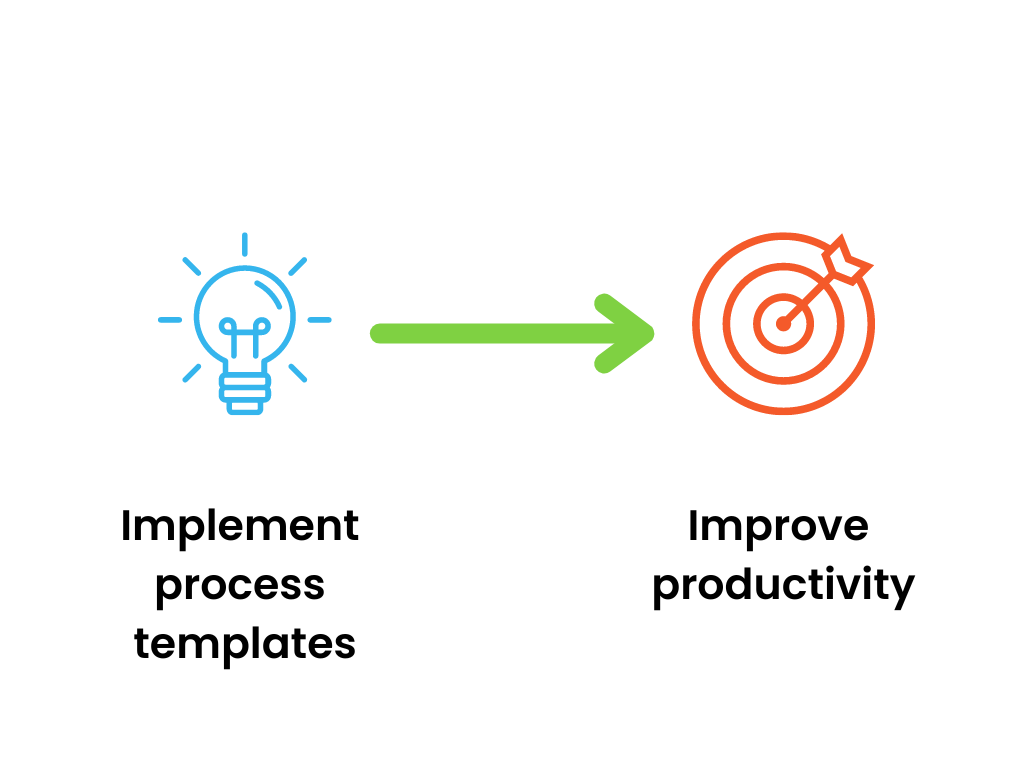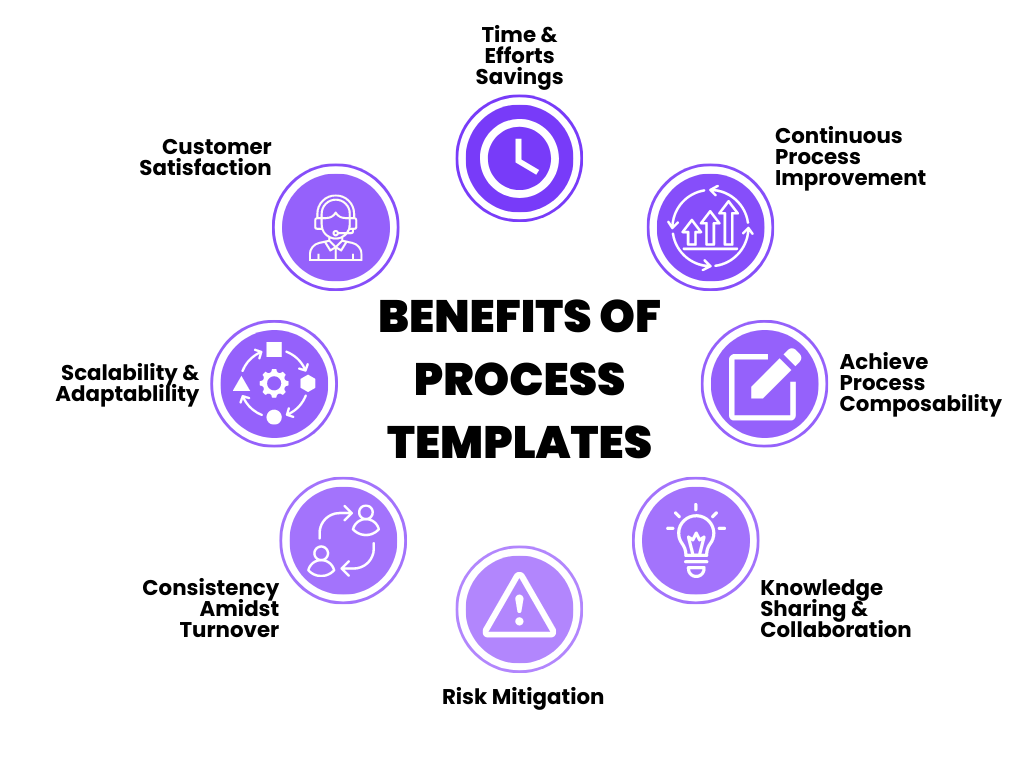It’s been some time since we announced our Spring Release ’23, but some of our new features might be unfamiliar to you. One of these features is Process Templates.
What does that mean? Let’s break it down.
In this article, we’ll discuss…
- The definition of Process Templates
- How Process Templates work
- How to improve productivity
- Flexibility and scalability
- Top 10 benefits of Process Templates
Our Process Templates are ready-made blueprints that provide a head start in designing and implementing new processes. This innovative feature saves time and promotes consistency and collaboration across teams. This feature solves a common work problem: spending too much time on small, repetitive tasks and not enough on big ones. Process Templates drastically cut your task time.
How Do Process Templates Work?: A Seamless Starting Point
Business process automation (BPA) includes dozens of touchpoints. You may need to involve team members, connect with third-party software, or organize a squadron of RPA bots. Starting with a clean slate every time can be time-consuming and frustrating—and risky.
With ProcessMaker Process Templates, you can quickly repurpose existing processes you’ve already vetted.
How does it work? When you open the Process Modeler in ProcessMaker Platform, you can choose from various pre-made templates.
These templates cover a wide array of business processes, such as employee onboarding, invoice processing, leave management, and more. These templates outline the inputs, outputs, roles, responsibilities, decision points, and steps involved in executing a specific process.
By choosing a template that closely aligns with your organization’s common goal, you can jump-start the process creation phase. The templates serve as a solid foundation, providing a structure and flow that you can customize to suit specific needs.
In addition to the set templates in ProcessMaker Platform, we also have a growing collection of free templates available. You can use these templates to start your next project. Find them in our Template Gallery.
How Process Templates Improve Productivity
A study by Asana found that employees waste about 4 hours and 38 minutes each week redoing work that already exists. That means redoing reports they don’t know someone else already wrote. Asking questions that have been answered. Going back to the drawing board instead of using a pre-existing strategy.
Here’s where process automation templates can really help your team. Instead of working regressively, employees and collaborative teams can spend more time moving forward.

A Process Template might include the tasks needed to:
- Open a new account
- Look up customer details in an ERP
- Onboard or offboard an employee
- Process an invoice
- Handle an incoming form or application using intelligent document processing
- Assign a hot sales lead
- Generate a report
- Fulfill an order
- Verify an employee expense
- Conduct a performance review
- Manage a new contract
- Schedule an appointment with a technician
- Submit for vacation leave or CapEx request to a manager
Instead of starting over, team members can pluck the approved process and drop it into a new one.
For example, say you have a sequence of tasks that guide your customer service team through opening new accounts by phone. But you’re looking to add a self-service option that users can fill out at their leisure. Process Templates help you get a head start by using steps that you already know work. You can then adjust them for a similar but new purpose.
Flexibility to Save and Reuse for Seamless Collaboration
Process Templates go beyond offering predefined models; they empower you to save your own processes as templates.
After you create or modify a process, save it as a template that you can use again in the future. With this feature, organizations can establish a library of customized templates that align with their unique business requirements and operational processes.
When future projects arise, users can leverage these saved templates, significantly reducing the time and effort required for process creation. This functionality streamlines the distribution of best practices and fosters collaboration, where employees can freely share and implement process improvement ideas.
Top 10 Benefits of Process Templates
The primary goal of Process Templates in business process management (BPM) is to enhance standardization, efficiency, and quality. Armed with a high level of consistency, you can reduce confusion, errors, and unintended variation across your most important processes. Here are the top 10 advantages of working with Process Templates in ProcessMaker Platform:

1. Time and Effort Savings: Once you get it right, why reinvent the wheel? Users can simply choose a template that closely matches their requirements and customize it accordingly. This accelerates the early stages of process creation and frees up valuable time and resources for other critical tasks.
2. Continuous Process Improvement: Process Templates work hand in hand with the backbone of building effective processes: process improvement. Continuous testing and analysis make the processes most effective. By using existing building blocks, you can repeatedly iterate until you’ve found the best-performing sequence of tasks.
3. Achieve Process Composability: With Process Templates, cogs in your process machine exist as individual components. Easily swap and repurpose parts of your workflow into brand-new processes. Users can avoid common pitfalls and design processes that are optimized for success by leveraging predefined models.
4. Knowledge Sharing and Collaboration: The ability to import and export templates facilitates knowledge sharing and collaboration among team members. Users can tap into the expertise of their colleagues by importing templates created by others, leading to continuous process improvement. Additionally, exporting templates allows organizations to standardize processes across different teams, departments, and countries.
5. Risk Mitigation: Eliminate the likelihood of errors and delays. When everyone on your team uses pre-approved templates, it reduces the chances of new processes encountering unexpected problems.
6. Consistency Amidst Turnover: Every company struggles with maintaining an institutional knowledge base. When a key team member departs, teams often scratch their heads, unsure exactly how to perform vital duties. Process Templates ensure no one leaves with the “how-to” recipe locked inside their head. You’ll have an airtight record of best practices that you can tap into when it’s time to build new automated processes.
7. Scalability and Adaptability: As organizations grow and evolve, their process requirements may change. Process Templates provide the flexibility to adapt to these changing needs. Users can easily modify or create new templates based on evolving business requirements. This scalability ensures that processes align with organizational goals and allows for adjustments as needed.
8. Maintain Regulatory Compliance: Process Templates are a vital BPM feature for industries heavy on compliance requirements. By following existing templates, organizations can systematize rules and regulations between teams. Templates can include quality control checkpoints, user access rules, and performance indicators so all processes follow the same criteria.
9. Improved Employee Training: Process Templates serve as a valuable resource for training new employees. Newcomers can refer to templates to understand the steps, tasks, and roles involved in the various processes under their purview. This reduces the learning curve, guaranteeing that new hires follow established procedures from the very start.
10. Sky-high Customer Satisfaction: McKinsey lists “consistency” as the secret ingredient of customer happiness. When customers engage with your brand, they love to know what to expect. Whether they’re paying a bill or updating account details—consistency is key. Process automation templates establish a dependable experience that boosts trust amongst your user base.
How does IPA boost Hyper-Productivity?
Intelligent process automation (IPA) can be a game-changer for your organization in more ways than one. One of the most significant ways you can transform your workflow is by boosting Hyper-Productivity. Instead of simply being productive, your team can become Hyper-Productive, completing work faster and more efficiently than ever.
Trying to find the right software for your organization’s needs? We’re here for you! Chat with our team to find the right fit for your business (even if it isn’t us!)






